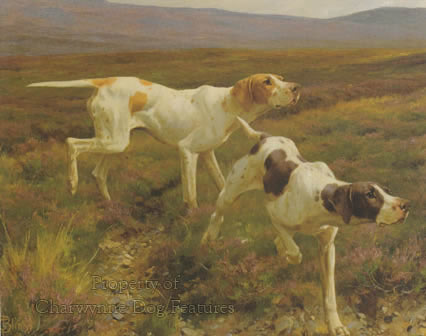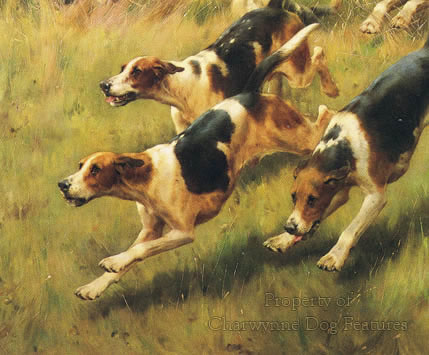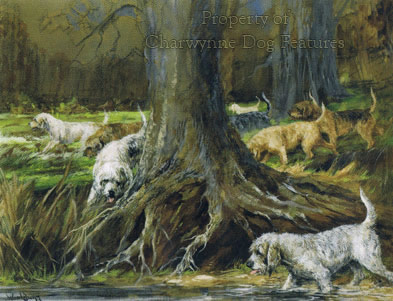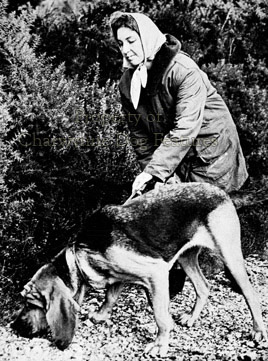702 HUNTING BY SCENT
HUNTING BY SCENT
by David Hancock
 “The reasons of good or bad scent is a puzzling Theme to the Sportsman. Scent cannot be ascertained by the Air only, it depends also on the Soil, doubtless the scent most favourable to the Hound, is when the Effluvia constantly perspiring from the Game as it runs, is kept by the gravity of the Air to the height of his Breast, for then it neither is above his reach, nor need he stoop for it…Scent also varies by difference of Motion, the faster the Animal goes, the less scent it leaves…”
“The reasons of good or bad scent is a puzzling Theme to the Sportsman. Scent cannot be ascertained by the Air only, it depends also on the Soil, doubtless the scent most favourable to the Hound, is when the Effluvia constantly perspiring from the Game as it runs, is kept by the gravity of the Air to the height of his Breast, for then it neither is above his reach, nor need he stoop for it…Scent also varies by difference of Motion, the faster the Animal goes, the less scent it leaves…”
Those words of the Rev WB Daniel in his “Rural Sports” of 1801 indicate the long-lasting complexity over the assessment of scent in the sporting world. The more perceptive writers on dogs have long appreciated the overriding importance of the canine sense of smell. Gundog authority Wilson Stephens in his quite excellent book "Gundog Sense and Sensibility" has written: "To gundogs, with centuries of nose-consciousness bred into it, noses are for serious business, eyes merely come in useful occasionally"... going on to state that he had never needed to teach a dog to use its nose but usually had to teach one to mark the fall of game using its eyes. There is evidence however of sporting dogs developing better and working more effectively when their rapport with their handler is closer. The great packhound expert Newton Rycroft once wrote in Hounds magazine “I cannot see what it profits a hound or pack of hounds to have inherited good noses if their huntsman has not the time, patience nor the sensitivity to allow them to develop these good noses to the full.” 
Research in North America has been conducted to assess the effects of conditioning and nutrition on the performance of working Pointers. Eighteen Pointers, aged between two and four, were split into three groups. Six Pointers were fed a diet of 12% fat, another six ate a diet with 16% highly saturated fat, and six were fed a diet of 16% mostly unsaturated fat. In each group, half the dogs were exercised on a treadmill three times a week. Once a week, researchers measured the dogs’ scenting ability, gave them an hour long ’stress-test’ on the treadmill, then measured their scenting ability again. Conditioning, or lack of it, showed a profound effect on scenting ability. The dogs not receiving conditioning showed a 70% decrease in post-exercise scenting ability. But the dogs fed the highly saturated-fat diet showed an even greater decrease in scenting ability, hinting that dietary fat plays a role in keeping dogs’ olfactory systems working well.
The highly-experienced sportsman "Wildfowler" in his "Dog Breaking" of 1915 gave his list of setter qualities in this order; "Nose, pace, energy, style and indomitable endurance"...no doubt in his mind of the value to man of dog's sense of smell. But to limit scenting powers just to the nose is not entirely correct. In his informative "The Mind of the Dog" (1958), vet, exhibitor and sportsman R.H.Smythe recorded this: "Now, odours, scents or smells represent the delights of paradise to every dog...it is well known that delicate smells make the mouth water. Saliva dissolves the scent-bearing vapours and so the dog not only smells them but also tastes them. It is believed that hounds use both smell and taste, especially when the scent becomes strong, and it is believed by many that when hounds 'give tongue' they are actually savouring the delightful odour as it dissolves in their saliva." In pursuit of this belief our ancestors utilised the "shallow flew'd hound" to hunt by sight and scent, in that order, as a "fleethound" and the "deep-mouthed hound" as a specialist scenthound.
There is a link too between well-developed sinuses and the ability to track. The best trailers have the skull-conformation to allow good sinus development, adequate width of nostril and good length of foreface so that there is sufficient surface between the nostrils to house the smell-sensitive lining membrane. Scenthounds, gundogs and other hunting dogs depend on the shape of their skulls for their acute smell-discrimination. In pedigree breeds, the wording of the description of the skull in the breed standard can therefore directly influence the scenting prowess of the dog. The narrower skull of the terrier leads it to prefer to hunt by sight, show less interest in following a trail of scent yet, through selective breeding, show enormous interest in scent coming from below ground. Flat-faced dogs have limited scenting skills; space is needed for olfactory receptor cells.
Imagine the delicacy of scent that allows a gundog, at some distance, to distinguish between a partridge and a lark, a pheasant and a woodcock. The greatly-esteemed General Hutchinson, writing at the turn of the century in his classic work "Dog Breaking" advised hunting Pointers and Setters together, stating on the subject of scent that..."on certain days - in slight frost, for instance, - setters will recognise it better than pointers, and, on the other hand, that the nose of the latter will prove far superior after a long continuance of dry weather". The different breeds often display definite strengths in such a way and so too do individual dogs. Poodles were found able to detect truffles better than most breeds, including hounds and gundogs.
In his book “Hunting” of 1900, hound expert Otho Paget links hound intelligence with scenting ability, stating that the remarkable ability to follow weak scent on roads possessed by some hounds was rooted in their memory and reasoning powers, warning that “One of the greatest objections against breeding hounds too close is that their brain-power becomes reduced.” Dogs can detect some odours at one thousandth the concentration detectable by man. But nature can have its own ruses. The Game Conservancy found that incubating hen grouse stop producing the caecal droppings which give them their characteristic smell, thereby reducing the chances of detection by a predator or game-seeking gundog..jpg)
No scientist has ever been able to explain satisfactorily the mysteries of scent in the hunting field. Scent is variously affected by the direction of the wind, heavy rain, freezing fog, high humidity, different crops, baking heat and the ground temperature. But no one has confidently stipulated the conditions needed for good scenting. In his book “Hunting by Scent”, HM Budgett records research confirming that the temperature of the ground just below the surface, relative to that of the air, is critical in determining scenting conditions. He refers to them as good or bad, according to whether the earth is warmer or cooler than the air. But he admits that his prediction was a likelihood not a precise indicator. Alington, another expert on hunting by scent, once observed that 'scent is almost certain to be good between 3.30 and 4.30 after a warm October day, when the thermometer suddenly drops to near freezing point.' He then hastened to add: 'Under no other conditions would the writer care to back his opinion that scent will be good'! Not a lot of value there then! No wonder the scientists stay away.
“It appears that the English insist upon a hound with a long neck, so that he can stoop to a scent; this is a proof, according to the oracle, that most of our foxhounds have not very good noses. The Saintonge hound – an ancient and eminent French breed – hunted with his head up (le nez au vent), without deigning to stoop. This is still a characteristic of a well-bred hound – both in pointers and hounds – but M. de Chabot goes on to say that he has often remarked slow-looking hounds keep right up at the lead, and throw their tongues admirably owing to the way they carried their heads and the way their heads were put on. In our love of drive and pace the French think we have sacrificed nose…”
From ‘The Queen’s Hounds and Stag-hunting Recollections’ by Lord Ribblesdale, Longmans, 1897.